Killing Bighorn to Save Bighorn?

It‘s hard to name a modern wildlife “management” practice that does not involve killing some plant or animal to “help” other plants or animals to the unintended detriment of all.
The idea that humans can improve on nature would be laughable but for the damage being done to wild animals and their habitat by people who believe this. They seem to think that nature consists of many independent pieces, which can be manipulated or “managed” to produce a desired outcome, with minimal side effects. Such “management” (it should be called mismanagement) generally includes attacks on biodiversity with poisons, machines or guns. These have unintended consequences which prompt inappropriate responses—usually, harsher attacks on biodiversity—that produce additional unintended consequences and more inappropriate responses in a downward spiral.
Here is an article that shows where this leads. After 100 years of disrupting natural processes across the West, including the removal of domestic and wild “competition” including predators, bighorn sheep are disappearing because of pneumonia, a commonplace disease which is ever-present but resisted in healthy animal populations. The experts declare that predators and domestic animals are the culprits. And now their solution to save the bighorn is killing out more predators, removing all domestic sheep, and finally, killing the bighorn sheep themselves.
Contrary to their assumptions, disease and parasite outbreaks among bighorn, quail, deer and pronghorn are not root causes for which there is a silver bullet (the pun is intentional ) that will restore animals and habitats to health, but rather symptoms of their own bad practices. It is the disrespect of nature in agricultural, ranching and wildlife practices that has brought us bighorn pneumonia. It created and spreads Chronic Wasting Disease (CWD) among deer and elk, and is responsible for declining pronghorn and quail. Yet the more they fail, the more confident the agencies and universities become that the same practices that have produced these results will lead to different outcomes in the future. An uninformed, gullible and inattentive public goes along.
Texas’ own bighorn sheep program has generated a long attack on pre-existing wild animal populations. Yet, the golden period of rapid growth of the Sierra Diablo herd, the largest in Texas, started about 20 years ago during a period of benign neglect, when in 1997, despairing “managers” freed a captive herd from confinement in breeding pens and practices that had made them so sick they were not expected to survive. Left alone except for supplemental water, sheep thrived — alongside many domestic and wild animals – which included elk, aoudad and many predators. Between 2002 and 2008, sheep numbers more than tripled.
Then about 10 years ago, the Texas Parks and Wildlife Department (TPWD) along with many Texas landowners got sold on a bundle of deer practices intended to create artificially high numbers of “trophy” deer on small properties. Among many harmful practices is the diligent reduction or removal of predators and many animal species to reduce “competition.” Reinforced by invasive species biology, a plant and wildlife ideology that treats biological bigotry as science and has come to dominate conservation thinking, TPWD began to “manage” sheep through attacks on biodiversity.
Next door to Circle Ranch at the Sierra Diablo Wildlife Management Area (SDWMA), the folks prescribing removal of domestic and wild sheep to “save” Montana bighorn wrote a Management Plan in 2006. Under their plan, as many cougar, coyotes, bobcat and other predators as possible are shot, often from helicopters. Mule deer does are “harvested” at a number per acre which if followed by private owners would almost eliminate mule deer across our county. All native elk, burros and exotics are removed along with all cattle and domestics to reduce “competition” and “biosystem harm.”

Aoudad, the only large herbivore that can deliver animal impact to the highest and remotest areas frequented by bighorn, have been all but extirpated. Sheep Program leaders say they pose a health risk to sheep even though they agree that there is not a single proven case of disease transfer between the two.
 The practices began in earnest in 2006. The graph above, which was furnished by TPWD Sheep Program Leader Froylan Hernandez, shows that since 2008 sheep populations have declined almost 30%. The Sierra Diablo subgroup had an additional decline of 6.5% between 2015 and 2016, which is not reflected on this graph. We have lost a decade of progress. Moreover, mature rams have disappeared altogether. Consequently, all hunting within the biggest herd in Texas has been suspended.
The practices began in earnest in 2006. The graph above, which was furnished by TPWD Sheep Program Leader Froylan Hernandez, shows that since 2008 sheep populations have declined almost 30%. The Sierra Diablo subgroup had an additional decline of 6.5% between 2015 and 2016, which is not reflected on this graph. We have lost a decade of progress. Moreover, mature rams have disappeared altogether. Consequently, all hunting within the biggest herd in Texas has been suspended.
Froylan says that some Sierra Diablo sheep are dying from parasites and Blue Tongue Virus (BTV). This he attributes to stressed populations that become susceptible to disease and parasites. We agree with him about stress. We differ as to whether attacks on biodiversity stress the system to the point that it comes apart, or whether the system needs even more eradications. As shown in our extensive interlined comments to their Plan, we warned TPWD against these practices, and predicted these outcomes, years ago.
I know and like many of these individuals. Yet, almost none think holistically, and the agencies of which they are a part do not base decisions on science as they claim. Pursuant to self-serving agendas, they promote discredited, harmful practices including cattle removals, range poisons and wildlife eradications, which they justify with the fake science of invasive species ‘biology’. Their outcomes speak for themselves: In our high-desert mountains, the reason to keep their wildlife “management” to a minimum is because, with the exception of adding water, most of it is bad for wildlife.
NOTE: the article below originally appeared on NWF.org on May 25, 2016. It was written by Michael Tennesen
Embattled Bighorns: Drastic steps to save bighorn sheep lead to clashes and compromise across the West
ON A CLEAR, COLD DAY LAST DECEMBER, a helicopter lifted off from an airport in Dillon, Montana, and headed southwest toward the Tendoy Mountains some 20 minutes away. The Tendoys are a small, remote range near the Idaho border with high cliffs, steep ledges and windswept ridges—terrain where agile bighorn sheep can forage, rut and roam.
Dispatched by Montana Fish, Wildlife and Parks (MFWP), the chopper held a marksman on a tough mission: to kill a bighorn ram suspected of carrying pneumonia. The effort was part of a broader plan to allow hunters to kill off every one of the 30 to 40 bighorns in the Tendoy herd—an unprecedented hunt in the state, designed to eradicate intractable disease and pave the way for a new herd to repopulate the region. Craig Fager, a biologist with MFWP, says his agency had tried for years to seed a new herd by importing healthy bighorns to the Tendoys, only to have recurrent disease defeat their efforts. “So we decided, why not try something new and see where it takes us.”
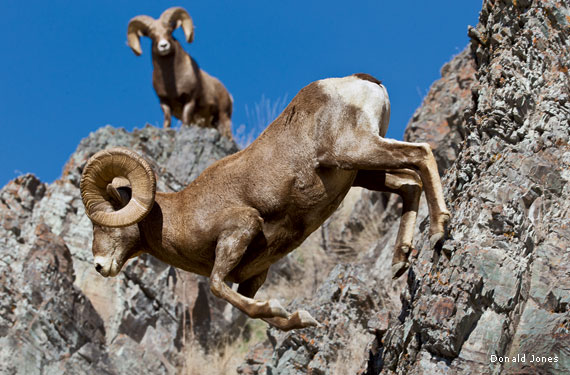
Montana is only one of several states taking drastic steps to save bighorns from disease. This February, for example, the Nevada Department of Wildlife (NDOW) discovered pneumonia in what had been a healthy herd of about 100 bighorns. Wheezing and frail, the herd suffered a 75 percent die-off, prompting NDOW to dispatch wildlife professionals to gun down the last survivors to prevent the disease from infecting adjacent herds. “Our guys were devastated by having to do this,” says NDOW spokesman Chris Healy. “But if we didn’t do anything, we had a good chance of this thing spreading.”
This “thing” is pneumonia, a severe respiratory disease that develops when susceptible bighorn sheep become infected with strains of Mycoplasma or Pasteurellaceae bacteria. Of the three subspecies of bighorns—Rocky Mountain, desert and Sierra Nevada—the first two have each suffered outbreaks in recent years, with herd die-offs reaching up to 90 percent.
“There are 15 states in the West that have bighorn sheep, and at least 13 have had pneumonia die-offs,” says Kevin Hurley, conservation director of the Wild Sheep Foundation. That’s especially troubling in light of population trends. By the early 1900s, bighorns had vanished across vast swaths of the West due to disease, hunting, predation and other factors. By the end of 2015, populations had recovered to roughly 85,000 animals thanks to costly restoration efforts. Yet those now seem threatened. Because bighorns are an iconic species with cultural and economic value to tribes, hunters and wildlife watchers, the recent disease losses have wildlife researchers and managers scrambling for clues—and culprits.
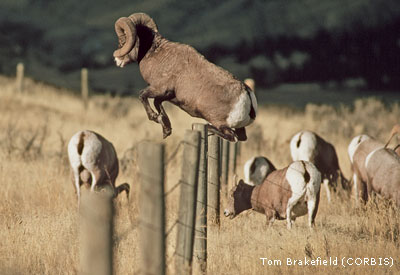 Showdown with Domestic Sheep
Showdown with Domestic Sheep
Numerous controlled studies show that bighorns can contract pneumonia after coming in contact with domestic sheep and goats, which often carry the disease-causing bacteria but generally show no ill effects. Unfortunately, such contact is easy to come by. Millions of domestic sheep graze on public-land allotments—vast acres managed by the U.S. Forest Service (USFS) and Bureau of Land Management (BLM)—that often lie adjacent to bighorn range. Escaped sheep may wander into bighorn territory, and bighorn rams roaming in search of mates may commingle with domestics. Contact doesn’t guarantee disease, but sheep can effectively pass a pathogen simply by rubbing noses or coughing near a bighorn, which can then pass it on to infect a whole herd.Bighorn Sheep jumping fence
“Only one effective contact is probably enough to trigger a pneumonia outbreak,” says Thomas Besser, a professor of veterinary microbiology and pathology at Washington State University who is researching pneumonia transmission. “Wildlife managers who detect bighorn sheep in contact with domestic sheep usually choose to kill the bighorn rather than risk it carrying the pneumonia pathogen back to its herd.”
Because there’s no known treatment or cure, pneumonia is best fought through prevention, which means keeping bighorns and domestic sheep apart. That’s where things get sticky.
In 2010, after years of scientific study, USFS banned domestic sheep from nearly 70,000 acres of grazing allotments in Idaho’s Payette National Forest, where die-offs had shrunk bighorn populations dramatically. Idaho sheep ranchers and industry groups sued to stop the move. The protracted case was finally resolved in March of this year, when the 9th Circuit Court of Appeals sided with USFS, allowing the ban to stand. “It’s a huge win,” says Brian Brooks, Sportsmen Coordinator for the Idaho Wildlife Federation. “Science prevailed.” Yet many sheep ranchers were disheartened by the news. “When something goes wrong,” says Peter Orwick, executive director of the American Sheep Industry Association, “I fear there’s too much attention placed on livestock being the culprit.”
Creative Approaches to a Crisis
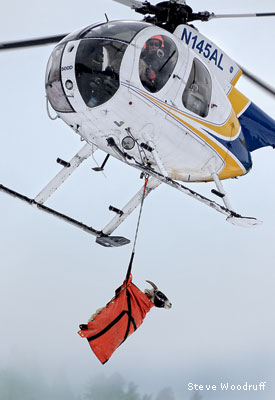
“Our goal is not to put people out of business, but we have to work together to develop solutions,” says Clay Brewer, chair of the Western Association of Fish and Wildlife Agencies’ (WAFWA) Wild Sheep Working Group, which hailed the court decision. “Domestic and bighorn sheep can both be on the landscape, but they can’t be in the same spot at the same time. It’s that simple.”
Though finding solutions is anything but simple, the National Wildlife Federation and many of its affiliates—including state wildlife federations in Colorado, Idaho, Montana, Nevada, North Dakota and Wyoming—are leading the way by developing collaborative programs to address the problem.
One such effort is NWF’s Wildlife Conflict Resolution (or Adopt a Wildlife Acre) Program, which compensates ranchers for giving up grazing rights in areas where livestock and wildlife may come in conflict. Because the Payette decision makes the future of such grazing allotments on public lands uncertain, ranchers now have more incentive to pursue alternatives.
“This program provides a market-based tool to help sheep operators while minimizing bighorn risk,” says Kit Fischer, NWF’s wildlife conflict resolution program manager, “and we’ve seen a surge in activity in the last two years.” Last August, for example, one sheep rancher in Idaho retired seven grazing allotments totaling 82,000 acres, for which he was paid more than $200,000, funded by several private conservation and sporting groups. This huge retirement benefits bighorns by reducing disease risk, yet it also helps protect prime sage-grouse habitat. In addition, eliminating domestic sheep from these allotments will provide more opportunity for grizzly bears to repopulate new habitat west of Yellowstone and into central Idaho.
Negotiating with sheep ranchers requires respect for tradition. “Recognizing a producer’s long connection to the land is crucial,” says Fischer. “But ultimately, raising sheep is a business, and any good businessman has to adapt to changing market conditions. Our program gives producers an opportunity that likely wouldn’t exist otherwise. They recognize that we are providing a solution and not just calling to complain.”
Even retiring a small allotment can make a big difference if the location puts bighorns at risk. To assess that risk, USFS, BLM and several western states and tribes developed a model called the Bighorn Sheep Risk of Contact Tool, which NWF and its affiliates recently endorsed as reflecting “the best available science” for pinpointing areas where domestic and wild sheep have the greatest risk of meeting. It’s one of many tools WAFWA is using in an effort to study bighorn herds across the West, standardize disease-testing protocols and develop management strategies to protect priority herds—“one of the best things we’ve done for wild sheep in decades,” says Brewer.
Closing in on a Killer
Such efforts are critical given that there are still unknowns about how pneumonia impacts bighorns. Some infected herds suffer huge die-offs, some lose just a few individuals, and others experience poor lamb production and survival over time. “There’s no consensus on how the disease works,” says Bob Garrott, a wildlife ecologist at Montana State University. “We think there are factors that make one herd resilient and robust and another susceptible to disease.” To learn more, Garrott is leading a six-year study of seven bighorn herds in Montana, capturing, testing and tracking animals to study their movements, population dynamics, physiology, nutrition and genetics—all factors that may impact disease.
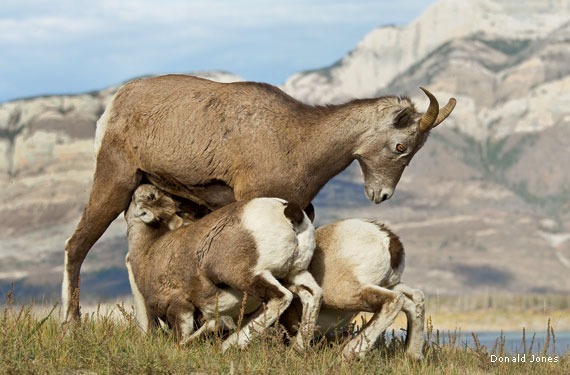
Slow Path to Salvation
Insights into such issues could spell life or death across bighorn range, where pneumonia continues its march. The disease recently flared up among desert bighorn in California’s Mojave Desert, far from large sheep ranching operations. “We never would have expected to find it here, but all of a sudden they’re dying like flies,” says bighorn researcher John Wehausen. In 2013, he says, ewes in one population plunged from roughly 140 to about 40 in a few months. And last summer, pneumonia killed a desert bighorn in nearby Joshua Tree National Park. Park ecologist Michael Vamstad thinks the disease may have come from contact with domestic goats, but the transmission route remains unclear.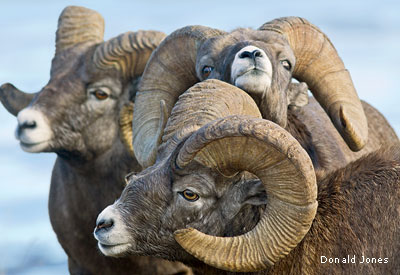
“We are losing ground,” says Tom France, Northwest regional director for NWF. “Lots of what we thought were secure herds have collapsed.” Efforts to shore up dwindling herds through transporting bighorns from one region to another have met with mixed success, as the Tendoy herd attests. So separation of bighorns from domestic sheep through retirement of grazing allotments—and collaboration among ranchers, hunters, wildlife managers, biologists and legislators—offers the best hope for a long-term solution to the crisis. “Disease transmission is a very difficult problem,” says Besser. “We’ll be wrestling with this for decades.”
Bighorn Sheep NWF at Work: Breathing Room for Bighorns
In March 2015, National Wildlife Federation affiliates passed a resolution endorsing separation of domestic and bighorn sheep as the best way to prevent transmission of pneumonia to bighorns. The resolution endorses voluntary retirement of domestic-sheep grazing allotments or conversion to cattle grazing on federal lands. NWF’s Adopt a Wildlife Acre Program has provided funds to help retire more than 1 million acres of grazing allotments to date, a boon for bighorns and other wildlife.
A Better Way for Bighorn
This 21-minute video shows how we husband bighorn alongside diverse wildlife without plant poisons or animal eradications.
Predators are necessary. Under the right planning, domestic animals can help because they increase the biodiversity and animal impact that plants and wildlife, including bighorn, need. Exotics are beneficial for the same reasons, especially those like aoudad that deliver animal impact to remote areas where bighorn live and where most native wildlife and domestic animals won’t go. These practices, in some form, will work for anybody who can recognize that:
- Plants need animals as much as animals need plants.
- Likewise, these animals need predators as much as predators need them.
- Mother Nature’s choices of plants and animals are not based on ideology or political correctness.
- Biodiversity is good not bad.
- Destroying biodiversity cannot increase biodiversity.
Drought Busters 101 from Christopher Gill on Vimeo.
